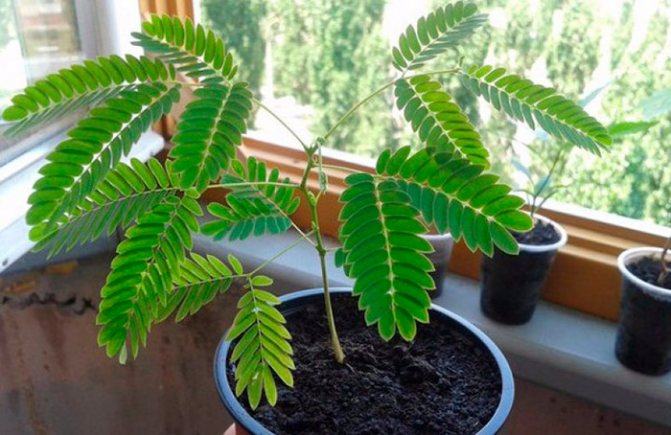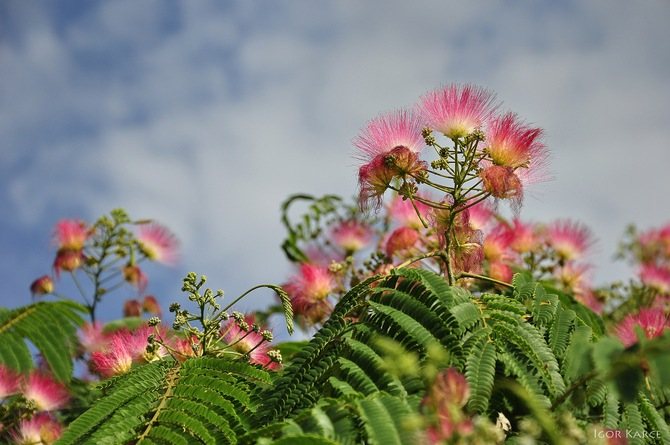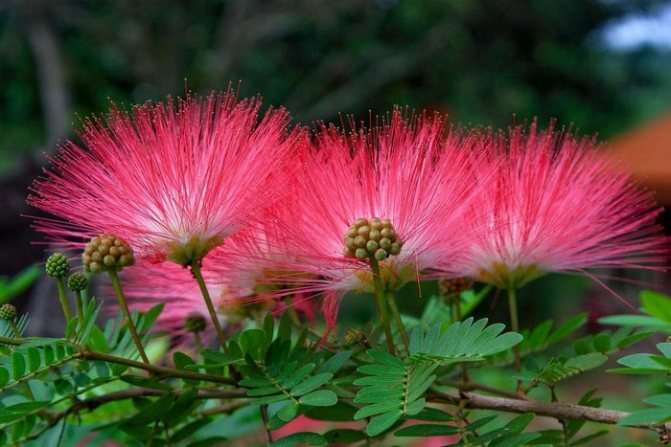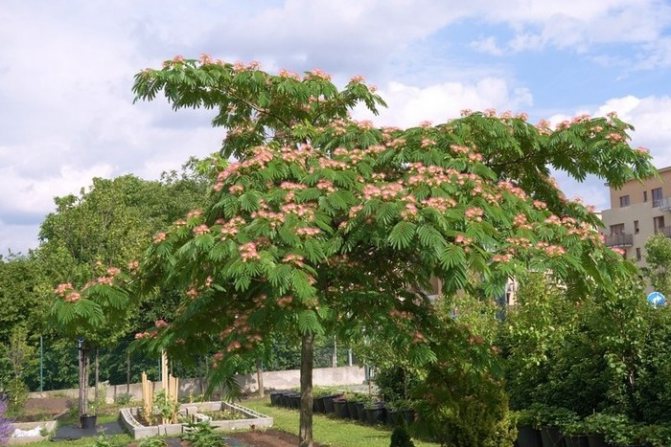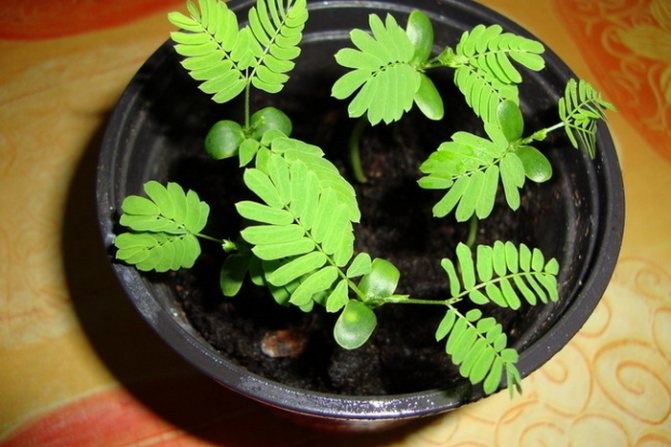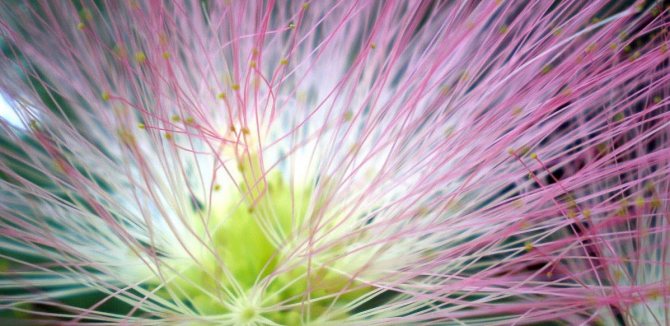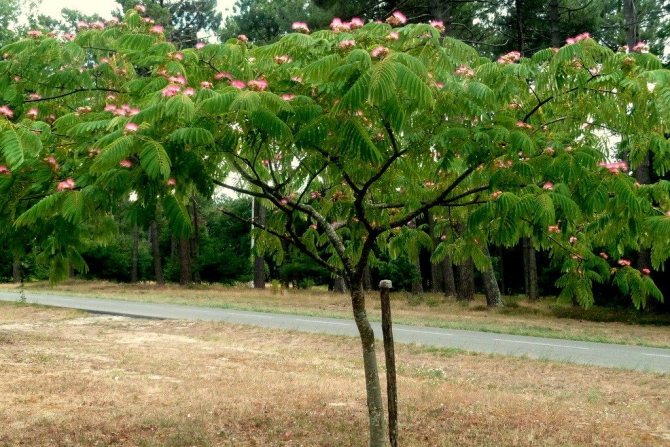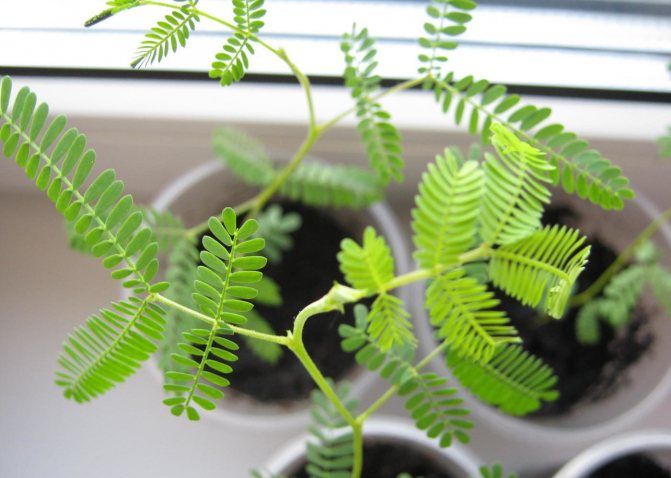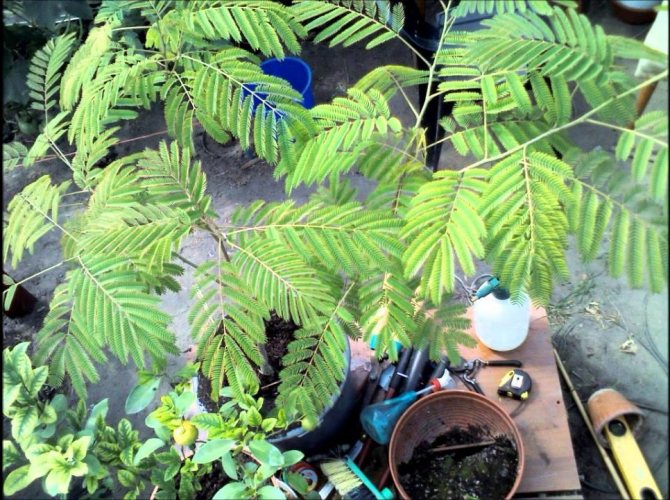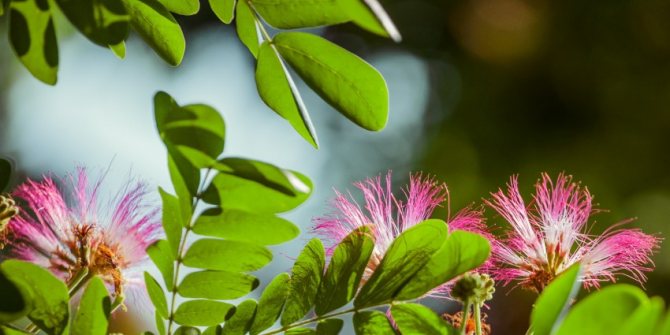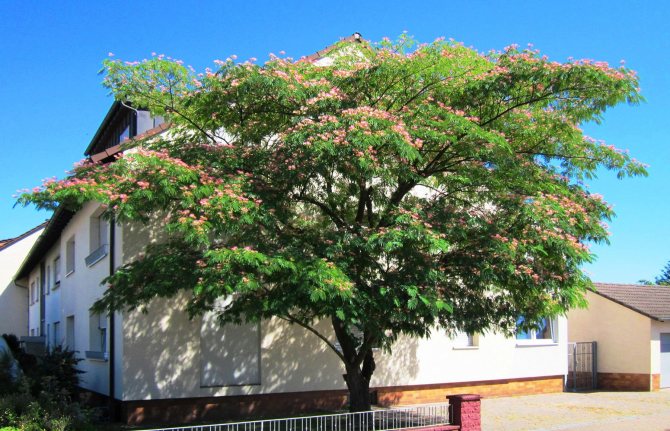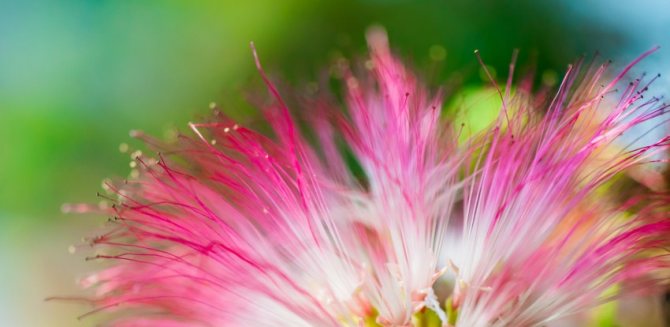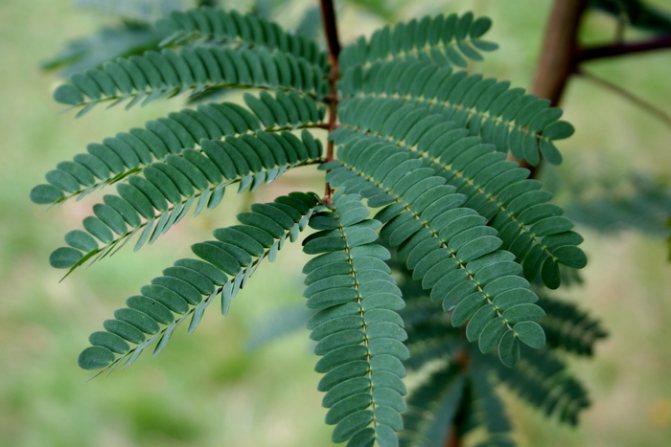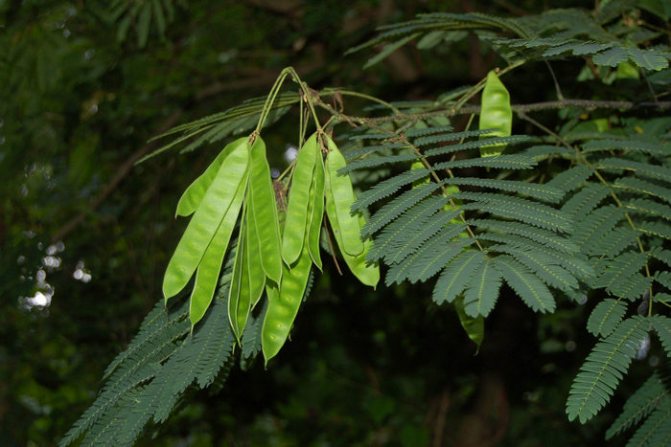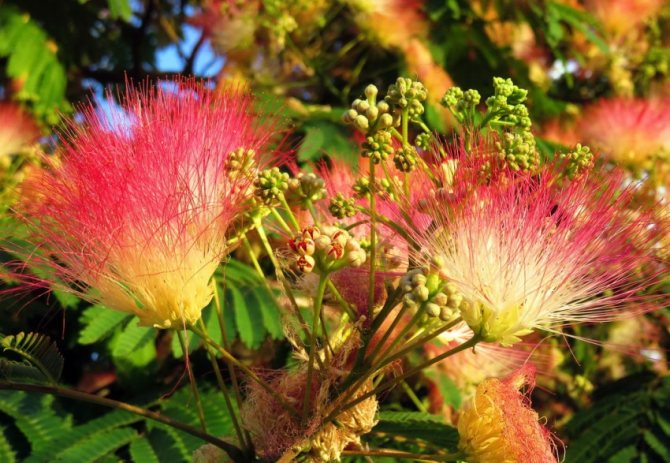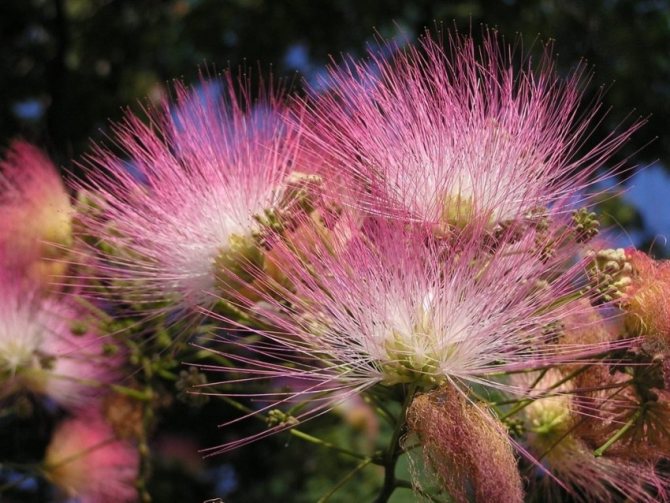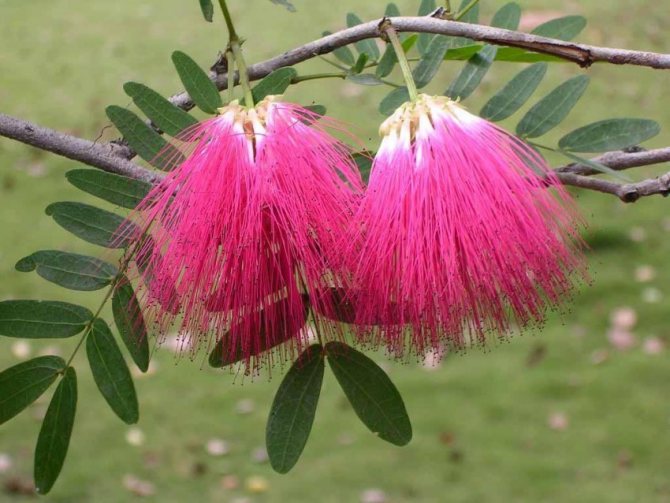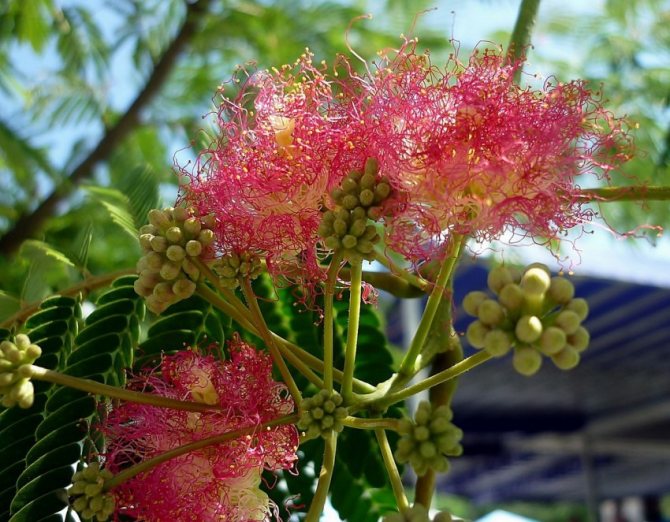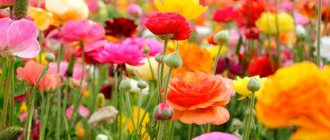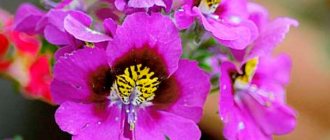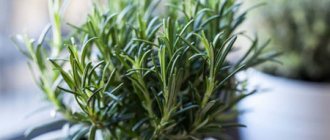Natalya Popova Wants to grow a tree
A bright representative of the genus Albizia, the legume family. In the wild, it is found in Asia, India, Japan, South Korea. The plant got to Europe relatively recently, in the 18th century. At the same time, in 1772, it received its official international scientific name - Albizia julibrissin.
Lankaran acacia (another name for the tree) - as a garden culture grows in the south of Russia and Ukraine. The tree is very thermophilic. Cases of freezing of acacia were recorded even in the Crimea and the Caucasus. I'll tell you about the features of the plant, its types and how to grow it.
Growing albition from seeds at home

Albizia seeds photo
- It is possible to plant albition with seeds at home already at the end of February - beginning of March.
- The beans must be pre-soaked in warm water to swell.
- Sowing in the spring in wide containers with a sand-peat mixture, and if there is enough space on the windowsill, it is better to plant it in individual cups with lids.
- Embed the seeds to a depth of 1 cm at a distance of 5-7 cm from each other and water.
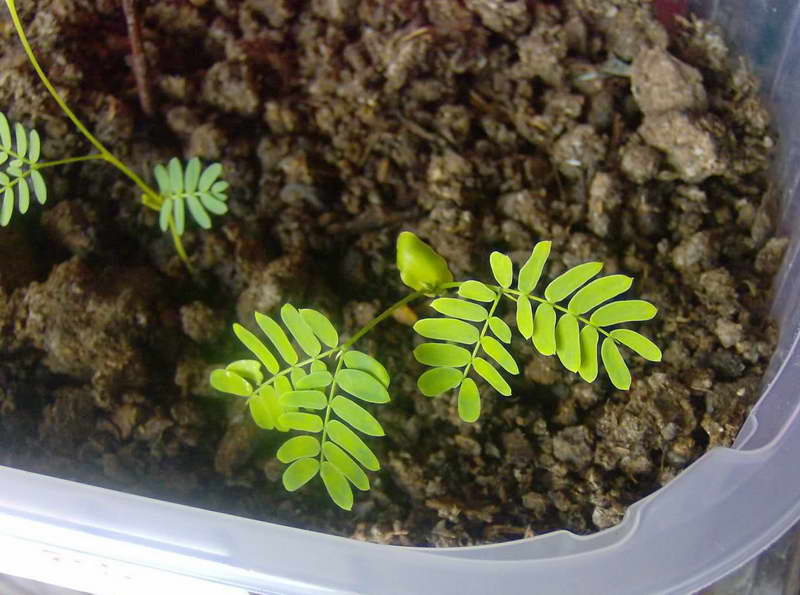

Albicia from seeds at home photo
- For successful germination, cover the top with a film or transparent glass, it is also necessary to provide diffused lighting and a temperature regime within 22-25 ° C.
- Do not forget to raise the shelter daily for ventilation, and when shoots appear, it can be removed completely, periodically moisten the crops.
- With a short daylight hours, it is advisable to organize supplementary lighting with phytolamps.


Albicia from seeds at home photo of seedlings
- When the seedlings grow up, plant them in separate containers. Grow indoors or transplant outdoors next spring.
Features of acacia


A great work on the adaptation of Albizia julibrissin to the conditions of climatic zone 7 was carried out by the famous scientist Rusanov
Beautiful flowers with a delicate refined aroma, a graceful silhouette of a tree, a spreading crown ... inevitably you will admire. But in the case of this plant, the desire and effort to grow it alone will not be enough.
The cultivation of silk acacia or Crimean mimosa presupposes the coincidence of a number of external factors. It's about the climate. Already in USDA Zone 7, outdoor cultivation of silk acacia is extremely problematic.
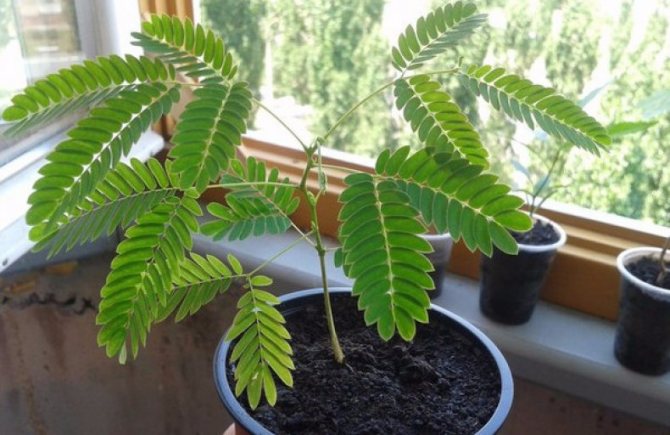

In USDA-zone 6, annual young plants must be cleaned indoors for the winter, otherwise they will freeze
Strong frosting of the shoots is possible in adult specimens. Usually, the tree is restored over the next year, but you should not allow frostbite. Good shelter is needed for the winter.
Planting and caring for albicia outdoors
How to plant
Albizia is planted in open ground in spring. Dig up the site, prepare the planting pits according to the size of the root system, lay a drainage layer on the bottom, then place a nutrient cushion of peat or humus, add 2-3 tablespoons of complex mineral fertilizer (nitroammophoska). Place the seedling in the center of the hole, sprinkle with earth and compact a little at the roots, the root collar should be flush with the soil surface.
Watering and loosening the soil
Garden albicia should be watered, especially in hot weather, but do not flood. Make sure that the ground in the near-trunk area is always loose and breathable.Although albitsia are used to create shading in recreation areas, it is categorically impossible to walk under them a lot: soil compaction directly under the tree is fraught with its death.
Mulching
To improve the structure of the soil, mulch its surface with a layer of humus 10 cm and renew it every spring. Such a simple procedure will ensure regular feeding of the tree, improve the condition of the soil in which earthworms and beneficial microorganisms will breed.
If there is no humus, compost or use cut grass for mulch.
Top dressing
Remember that top dressing should be applied along the edge of the trunk circle, no closer than half a meter away from the trunk. The suction roots are located at the tips of the root system, and by applying top dressing at the very trunk, you will not bring any benefit to the tree. And harm is possible.
You need to feed albition three times per season:
- In the spring, when budding, apply any nitrogen-containing fertilizer according to the instructions (for example, ammonium nitrate: 1 tablespoon per 1 square meter of the trunk circle). Spread mineral fertilizer over the surface and embed it into the soil with a hoe. Spring rains will quickly wash away the fertilizer and it will be absorbed by the roots.
- During the formation of peduncles, feed the tree with a complex mineral fertilizer: you can use nitroammofoska (2-3 tablespoons per square meter of the trunk circle), potassium humate, Kemiru Lux and other preparations.
- In late August or September, apply potash-phosphorus fertilizers to prepare the albition for a successful wintering. In no case do not introduce nitrogen, which will cause the branches to grow: they will not have time to ripen before the onset of cold weather and will be frozen over. Superphosphate and potassium sulfate are suitable for autumn feeding: take 3 tablespoons of superphosphate and 2 tablespoons of potassium sulfate, add per 1 square meter of area. Top with humus.
Pruning in spring
Spring work begins with pruning frozen branches. It is better to do this before bud break: carefully inspect the tree and cut off any damaged branches, as well as dried branches. Such a procedure has not only a decorative effect: in addition to a neat appearance, the tree will receive protection from diseases that settle in the damaged areas.
Do not be afraid if the tree is heavily coated: albition recovers very quickly and grows green mass. Even when completely cut to the root, it produces one or more shoots that replace the old trunk.
To prevent the transfer of diseases when pruning multiple plants, be sure to disinfect your garden tool.
Symptoms of improper care
Sometimes the plant does not bloom and looks unhealthy. There are several main signs of poor health of silk albicans:
- Dropping unblown flowers. The reason is the underfilling of the plant. It is necessary to water more often, not allowing the topsoil to dry out.
- Fading, blanching of vegetative parts. The reason is a lack of nutrients, improper watering, lack of lighting. Transplant into new soil with good aeration, constantly moisten the soil without stagnant water. Move the flower to a more illuminated place.
- Drying of leaves along the edge and at the tips. The reason is too dry air, possibly from heating devices. Spray the plant, move it away from the battery.
- Dark spots on the leaves. The reason is the wrong air temperature, drafts. It must be removed away from the vents, not placed next to the door.
The delicate foliage of albicia and the spicy aroma of its inflorescences will create a unique atmosphere in your home. Even not the most experienced florist can cope with an unpretentious plant, the main thing is to ensure proper watering and a sufficient amount of light.
The long history of migration of the decorative flowering tree has led to many names assigned to it by different cultures:
- Albizia Lankaran;
- Acacia of Constantinople;
- Silk albicia;
- Silk tree.
Frost resistance of albition and wintering conditions
The warm-loving guest from the tropics grows and develops beautifully in the southern regions of Ukraine and Russia; there were cases of freezing during cultivation in Baku and Tbilisi; cultivated in Uzbekistan, Turkmenistan, and in the south of Central Asia, Kazakhstan; grown in France, Italy, Albania, Greece.
On the territory of the South Coast, it successfully reproduces by self seeding. Over the years of cultivation, the plant has acclimatized to more severe conditions - it grows on the territory of Krasnodar, where you can no longer find any tropical plants.
- Albizia successfully tolerates a drop in temperature to -15-16 ° C, at -18 ° C young shoots freeze slightly.
- When the thermometer drops to -20-22 ° C, the main branches of the crown may already suffer, and if, in the absence of snow cover, such temperature indicators last more than 10 days, there is a high risk of freezing of the entire aboveground part.
So, in the open field, albition is grown in southern regions with a mild climate.
The cultivation experience is shared by the gardener Vladimir from Tikhoretsk (Krasnodar Territory):
“The main problem in growing albitsia is that it“ hibernates ”, stopping sap flow by mid-December, if the tree did not fall asleep and frost hits even up to 10 degrees, the trunk will freeze. But the root withstood frost up to 30 degrees in January. For the first two years, the trunk froze, in the 3rd and 4th years it did not freeze, apparently they managed to stop the sap flow before the frost. Interestingly, after trimming the trunk this spring, it began to grow to the sides, and so there was one large trunk and two or three smaller ones. I cut them off too, left one by one the largest. "
General information
Albizia owes its name to botany Filippo del Albizzi. He was the first to bring this plant to Europe.
Albizia Lankaran (Albizia julibrissin) belongs to the legume family (Fabaceae). It has other names: Lankaran acacia, silk albitsia, Crimean mimosa, julibrissin albizia. This tree reaches a height of just over 10 meters. The roots are located at the soil surface. The smooth gray bark cracks with age. Delicate white flowers have a large number of long pink stamens. Silk tree bears fruit in pods up to 20 cm long, which contain seeds - beans. The leaves are openwork, light green, reminiscent of mimosa foliage. It is a deciduous plant.
Grows wild in tropical climates of Australia, South Africa, South America. It is cultivated in subtropical regions.
Varieties of albition
Lankaran acacia is widely known in Crimea... The dense, spreading crowns of this plant are used not only for decorative purposes, but also to create shady alleys. It should be borne in mind that Lankaran acacia has low frost resistance, therefore, for the winter, its young shoots are covered with spruce branches or special covering material. This plant tolerates frosts down to -15 ° C. At home, a variety called Albizia Pompadour is common.
The genus Albizzia is also known for the crescent albicum (Albizzia falcata). This fast growing tree in Indonesia is grown commercially for cellulose production.
Albizia Lankaran Cultivation at home
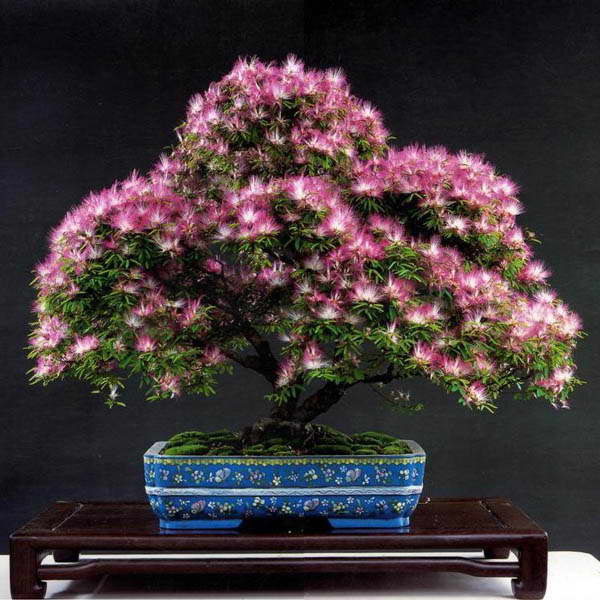

Bonsai from albicia photo
Air temperature and illumination
For indoor cultivation during the warm season, keep the temperature in the range of 20-25 ° C; in winter - 10-15 ° C, will not withstand a drop in temperature even up to +5 ° C.
Indoor albicans should also be protected from direct sunlight at noon. Place by an east or west facing windowsill. Ventilate the room regularly to provide fresh air, during the warm season, transfer to the balcony, veranda or garden.
Soil, air humidity and irrigation
The soil is preferable loose, neutral reaction, 1/3 consisting of sand.
In room conditions, water the plant with softened water (filtered or settled for several days). When growing indoors, provide abundant watering throughout the spring and summer, do not allow moisture to stagnate, gradually reduce watering by winter.
Albizia perfectly tolerates air of medium humidity, so there is no need to spray the plant or carry out other actions to increase the humidity level.
Top dressing and pruning
Fertilizers should be applied starting from the second year of life. Feed during the spring and summer period every 15 days. Use complex mineral fertilizers for flowering (Kemira Lux) or special fertilizers for acacias.
Perform sanitary pruning in the spring, you can form a bonsai-style tree.
Transplanting room albicia
Young albitsia should be replanted annually in the spring. The soil is sod land with the addition of peat and sand. Lay a two-centimeter drainage layer at the bottom of the planting container (this can be expanded clay, pebbles, clay shards).
For plants up to three years old, buckets or large tubs are suitable as containers. Then plant in a spacious box, a large plant will be difficult to replant - so renew the topsoil every spring.
Diseases
Of the problems that are associated with the cultivation of albitsia, several are distinguished. Most of the reasons are associated with violations of the soil moisture regime.
- Withering of leaves occurs in case of waterlogging or drying out of the soil. To avoid this effect, it is necessary to adjust the irrigation regime or change the land to a lighter one.
- In the case of a lack of moisture, the following phenomenon can still be observed: the tips of the leaves dry and brown or the buds fall off. For these reasons, regular watering is necessary.
- When a plant gets under the influence of drafts or with hypothermia, spots of a dark shade appear on the leaf plates.
- In low light, the leaves of the albicia lose color and turn pale. To solve the problem, you need to adjust the illumination, gradually accustoming yourself to increasing the light.
Diseases and pests
Albitsia is almost not exposed to diseases, difficulties arise with improper care:
- Drying out of the soil in the container leads to the dropping of flowers;
- Leaves wither both with insufficient watering and with waterlogging of the soil, it is necessary to adjust the watering;
- The leaves fade from insufficient lighting;
- Lack of moisture is manifested by drying out of the tips of the leaves;
- Dark spots appear on the leaves from a draft or sudden temperature changes.
Pests are extremely rare, but a whitefly or spider mite may be affected. Treat albition with an insecticide.
If you notice small orange spots on the tree, urgently cut off all damaged areas and burn them at the stake. This is a dangerous Coral Spot fungal disease that can kill the plant.
Possible difficulties in growing albicia
Also, improper care can lead to certain difficulties:
- Dry soil in the pot will cause the buds to shed.
- A dry or too wet substrate will cause the leaves to wilt.
- In insufficient light, the leaves change their color, become faded.
- Lack of moisture will dry out the tips of the foliage.
- In cold weather or drafts, dark spots will appear on the leaves.
If you take care of an albition tree or shrub, adhering to all the rules, then it will live long enough - both 50 and 100 years.
Vegetative reproduction of albition
Vegetative reproduction of albition occurs as follows:
Propagation by cuttings
- In late spring, cut the cuttings from last year's shoots.
- The length of the cutting should be 10-15 cm, the presence of several buds is also important.
- Make the bottom cut at an angle and the top straight.
- Remove the leaf plates from the bottom, cut the leaves 1/2 length at the top.
- It is advisable to keep the cutting in a growth stimulant solution (root, epin, heteroauxin).
- Root in loose soil (such as a sandy-peat mixture).
- Diffused lighting and an air temperature of 15 ° C will be required.
- The complete rooting process takes 3 months.
Reproduction by layering
To propagate albition with the help of layering, you should bend the extreme branch of the bush to the ground in the spring and dig in the groove, leave the top of the shoot above the soil surface. Keep the soil moist and separate the sprout from the mother plant next spring.
Propagation by root shoots
Often young shoots can be found around the plant - shoots from the main root. In the spring, we carefully dig them out with a shovel and plant them separately (in a container or on a site).
How to transplant albition of constantinople
A deciduous plant is transplanted before the start of sap flow and bud break. This is usually done in early March. Young specimens are transplanted annually. Starting from the age of three, the transplant is carried out every two to three years. Sometimes replanting a plant is compensated by replacing the topsoil. This technique is only suitable for adult acacias.
Albizia is a thriving crop and needs a spacious flowerpot. Acacia need a loose, well-ventilated substrate. From industrial soil mixtures, soil is suitable for decorative deciduous crops. Experienced gardeners prefer to harvest the ingredients for the soil mixture on their own. Home soil is prepared by mixing calcined sand with turf soil, crushed peat in a ratio of 1: 3: 2.
A high-quality layer of drainage material should be laid at the bottom of the flowerpot for a good outflow of excess moisture. Methods and rules for breeding an ornamental bush
There are two most common breeding methods for the Lankaran albition:
- germination of seeds;
- deposition of overgrowth;
- rooting of cuttings.
The first method is used in the presence of seed and does not present much of a hassle. Productivity depends on the freshness of the seeds. They resort to cuttings when there are no acacia beans at hand.
Seed propagation is not very difficult and consists of the following:
- Seeds must be stratified within two days. Use both hot and cold methods to speed up the development of sprouts from seeds.
- Swollen seeds are shallowly embedded in a moist peat substrate.
- The bed is covered with polyethylene to maintain high humidity.
- The first shoots appear two to three months after sowing.
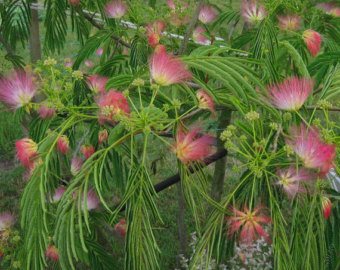

Reproduction of albition by root shoots is simple and highly productive. The only problem is that overgrowth appears extremely rarely in indoor conditions. It is recommended to remove it so that the planting does not thicken. These shoots are separated from the root system with a small part of the root and planted in a separate pot. Saplings quickly take root in a new place.
It is imperative to thoroughly disinfect the cut with a fungicide or activated carbon powder. Reproduction of acacia of Constantinople by cuttings allows you to get a new copy in the absence of seed. Suitable twigs are picked from waste after formative pruning or cut directly from the tree. It is recommended to select semi-lignified one-two-year-old shoots.
The length of the stalk varies between 10-15 centimeters. Excess leaves are removed, leaving two or three. The remaining leaf plates are shortened to reduce moisture loss. The twigs are planted in a substrate and removed in a cool place. Rooting of cuttings lasts one to two months. Experienced gardeners treat cuttings with growth stimulants to speed up the root germination process.
Rooted cuttings are planted in separate pots in early autumn. Follow-up care is no different from that of this culture.
The best views of albicia with photos and names
The genus includes more than 130 species, only a few of them are cultivated, consider the best.
Albizia Lankaran or silk (lat.Albizia julibrissin)


Albizia silk or Lankaran Albizia julibrissin photo
A tree with a straight trunk, reaching a height of 15 m. The leaf plates are double-pinnate, 18-20 cm long, each leaf is sickle-shaped, the arrangement is opposite. In hot weather and at night, the leaves curl up. In late autumn, leaf plates are dropped. Inflorescences are paniculate, spike-shaped in shape, whitish-yellow in color. The species is popular in culture in the south of Russia and Crimea.
Albizia beam-flowered Albizia lophantha
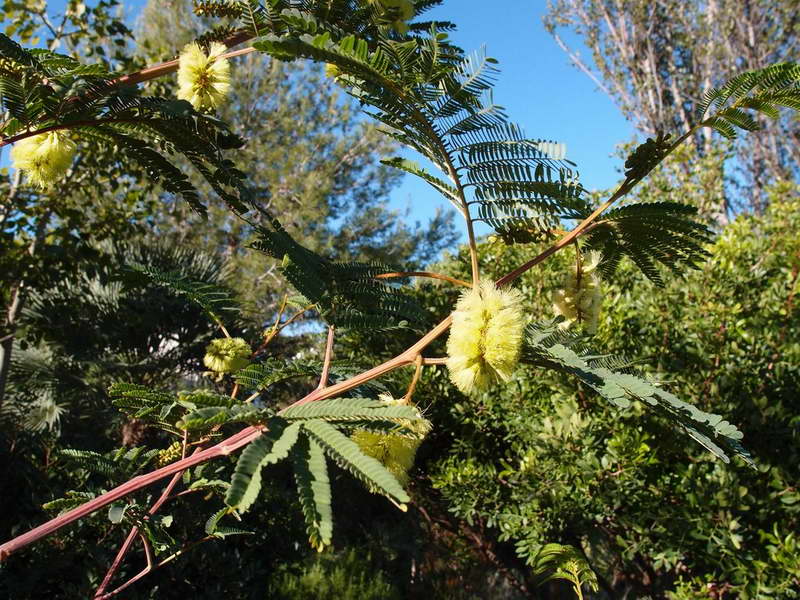

Albizia beam-flowered Albizia lophantha photo
Shrub about 6 m high, native to Western Australia. Leafy ones are similar to the above-described representative. Inflorescences are spherical, pinkish shade.
Albizia Lebbeck


Albizia Lebbeck photo
Distributed in Northern Australia and New Guinea, has become widespread as a domesticated species in the subtropical zone. In nature, it reaches a height of 18-30 m, with a trunk diameter of up to a meter! It is highly valued as a decorative landscape decoration, used in landscaping, shading zones, and is also used as a source of valuable wood and a medicinal plant for the treatment of colds, coughs, against inflammation of the upper respiratory tract, abdominal organs and skin.
Description
The tree is a member of the legume family (earlier this type of tree was called mimosa). This beautiful and fragrant exotic representative came to Europe thanks to Albizzi - her discoverer, as her name is now. But albitsia has another name - silk albitsia.
This tropical plant has a tree or shrub shape. The height of acacia often reaches ten meters. And the crown is seven meters in diameter. She lives from 50 to one hundred years. The bark of the trunks is dark brown.
The leaves of the exotic guest are unpaired pinnate, openwork in shape. They are divided into 9-15 beats. Each of them contains up to thirty pairs of leaves that sit on secondary petioles. This makes them delicate and decorative. The upper surface of the leaves is a dark green hue, and the lower one has a white-green color. The length of the leaves is twenty centimeters long. In the heat and at night, the leaves on the branches fold along the midrib. The complex sheet itself goes down, drooping. In winter, the leaves of the albicia fall off.
Flowers, collected in spherical panicles, inflorescences and distinguish them from the rest of the elongated stamens. For this feature, they are called staminate. These flowers are bisexual, have a five-ray symmetry. The shade of the flowers is white with a slight yellowness, red or pink. Albitsia blooms from July to August. During flowering, a heady aroma is carried around the plant.
The fruits of albicia, like all representatives of this family, are beans, at first green, and after ripening they acquire a straw-yellow or brownish color. The length of the bean leaves varies from 10 to 20 cm. When the wind blows, ripe bean leaves make a sound that resembles a quiet whisper. For this reason, in the southern countries of Asia, the tree is also called "talkative language". Seeds inside valves are oval, slightly flat, dull. The color of the fruit is brown or brown; each seed is 6-7 millimeters long.
Albition in landscape design photo selection


Albitsia in landscape design photo
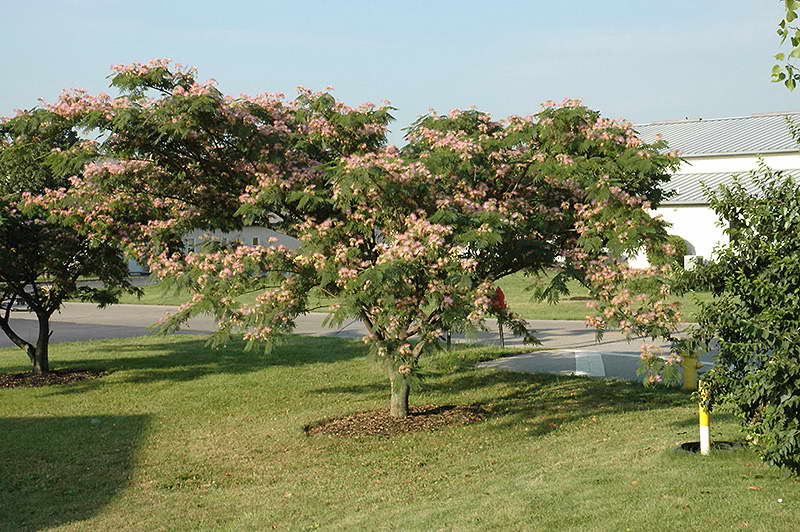

Young trees of albicia in urban landscape photo
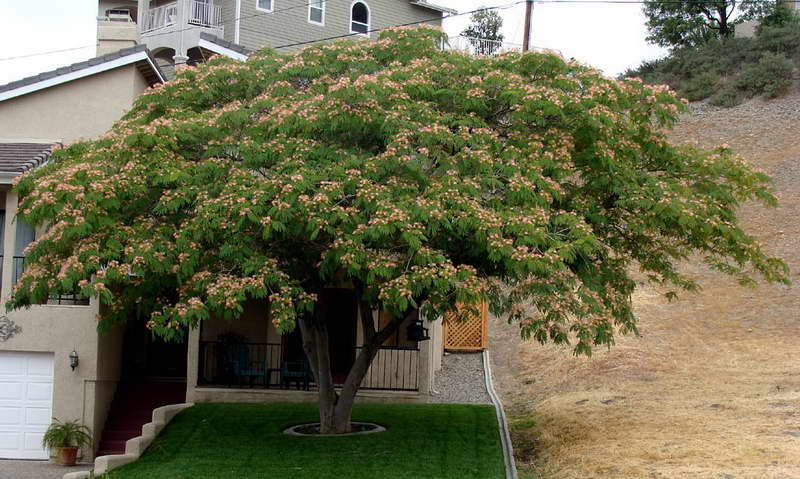

Albizia near the house photo


Albitsia and ornamental shrubs photo
Photo
Next, you will see a photo of Lenkoranka Akatsiya:
Distribution area and morphology
In nature, Lankaran acacia (albicia) is found in the countries of Western and Eastern Asia, Southeast Asia, on the Indian subcontinent, in China and Japan, and South Korea.As a decorative culture, it is popular in all Mediterranean countries of Europe, in southern Ukraine, in the Crimea, in the Caucasus. In Argentina, alleys and squares are planted from albits.
Acacia is a deciduous species. In natural conditions, it grows more than 15 m tall. The crown is spreading, shaped like an umbrella. The leaves are feathery, light green, up to 20 cm long. At night, acacia rolls up the leaves, in the morning it opens again. Reacts in the same way to too bright or direct sunlight.
Flowering begins in July and may last until September. Acacia blossoms with delicate pink inflorescences with a delicate indescribable aroma.
Attention! Acacia pollen is a strong allergen.
In autumn, fruits appear - long pods with seeds. Each pod usually contains 8-9 flat beans. After ripening, the beans spill out onto the ground. Around the same time, the tree prepares for winter by shedding its foliage. The root system of albition is highly developed, but shallow. This feature affects the frost resistance of the crop; at temperatures below -15 ° C, the tree dies.
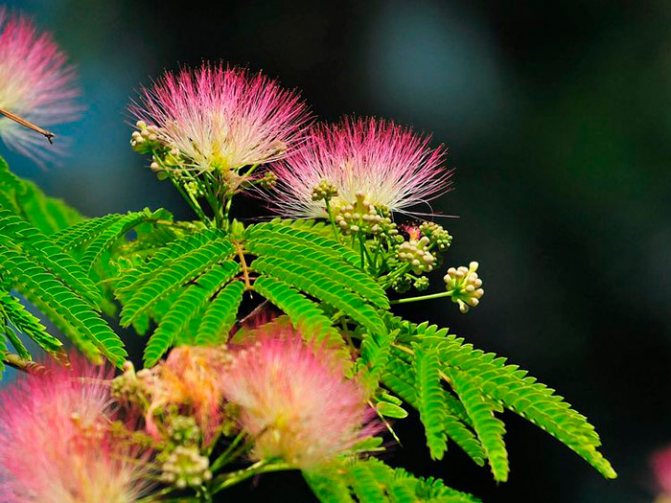

Lankaran acacia is known for its fast growth. In natural conditions, there are centennial specimens. At the age of 30, the bark of trees cracks, hollows appear. Young acacias have a smooth trunk, a uniform gray bark.
Botanical description
Adult albitsia are densely branched trees or large shrubs up to 10 m high and 15–40 cm thick trunks. The bark is dark gray, fine-scaled. The crowns are openwork, wide, umbrella-shaped, their diameter reaches 6–7 m. The root system is superficial, with many long shoots, at the ends of which nodules sensitive to nitrogenous compounds are concentrated. Leaves are dark green or bluish-purple, compound, double pinnate... On the central petiole, 17–20 cm long, up to 18 lobes are located oppositely, consisting of 20–30 pairs of small oval plates up to 10 mm long. In the evening, the plates close along the petioles - the leaves seem to close and droop.
In May or June, spicate or capitate bisexual inflorescences of light yellow or white color with many long pink or cream stamens, similar to fine hairs, appear on the albitsia. They make the flowers look fluffy.
Fruits are elongated pods 12–18 cm long, with a greenish-brown skin. Inside are seeds - flat beans measuring 7-10 mm.
Albizia is a fast-growing thermophilic species that can withstand periodic short-term drops in temperature down to –15 ° C, but frosty winters with little snow are destructive for it.


Growing and care
For the cultivation of albition in the open field, it is required to choose areas that are well-lit by the sun, protected from wind and strong drafts. Tropical acacia is undemanding to soil fertility, but does not like acidified clayey soils. For it, neutral loose loam or sandy loam is preferable. In heavy soil, sand and high moor peat must be added.
Planting is carried out in May, when the soil warms up to 15-18 ° C... Seeds must be pre-soaked in hot water for a day, buried by 3-4 cm. The seedlings are placed in holes with a volume twice as large as the root system of plants. A layer of stone drainage is placed on the bottom.
Domestic albitsia are planted in ceramic pots... For them, a soil mixture is prepared from equal parts of leaf and sod land, ¼ of the volume of peat and river sand. You should not choose large dishes - the culture will have to be transplanted periodically.


Humidification mode
Albizia is very fond of water. Watering should be done often: 2-3 times a week, but at the same time try not to swamp the root system. The topsoil should be constantly slightly damp to the touch. It is recommended to use soft settled or melted water warmed to room temperature... For watering - take nozzles with fine-jet sprayers.
The air in the room where the culture is contained does not need to be specially humidified. It is enough to water the soil in time and carry out cleaning, removing dust from all surfaces in the room.
Top dressing
In the first year of garden albicia, there are enough nutrients in the soil. Fertilization can be started from the second season. Fresh manure and other concentrated organic compounds must not be used. It is recommended to purchase complex mineral formulations for flowering plants... Nutrition is applied before watering once a year before laying flowers. If the tree develops slowly, top dressing is repeated at the end of summer.
Indoor albits are fertilized once a month until the end of the active growing season.


Transfer
Indoor young specimens are transplanted annually. The diameter of the new pots should be 3 cm larger than the previous ones. Before pouring the soil, they are washed and disinfected with a strong solution of potassium permanganate. The soil is used fresh.
Transplanting work is carried out at the end of winter or in March, while the plant has not started to grow... The root system is gently pry up with a small spatula along with a lump of soil and transferred into a new container filled with about ⅔ of soil. Then the roots are carefully sprinkled with the remaining soil. After transplanting, the plant is immediately watered.
Upon reaching the age of 3-4 years, there is no need for annual transplants. You can renew pots and soil once every 2-3 years.
Reproduction methods
The most common breeding methods for albicia are seed, cuttings and root shoots. The first method is suitable for garden and indoor crops, but rather long and troublesome. It is recommended to pre-stratify the material within two months. It can be germinated immediately in a permanent place, in a mixture of sand and peat, or in a special agrolite. The sprouts appear within 1–2 months.
Vegetative methods allow you to get new plants much faster... Lignified shoots of one year old are suitable for cuttings. Take their apical parts 10-15 cm long, cutting off at an angle of 45 °. The leaves are partially removed, leaving one pair. Before planting in the ground, the cuttings are treated with growth stimulants, deepened by 4–5 cm into the sand-peat mixture. They are looked after as for adult plants. Their own root system appears in 2-3 months.


Horticultural crops are propagated by root shoots... In domestic plants, it rarely appears. The accessory shoots are dug up in September, carefully separating them from the parent specimen. Shoots can be planted directly to permanent places in the garden or grown until the next warm season in indoor pots.
Lighting
Indoor plants are placed on the southwest or south sides. Young specimens will have to be shaded from the bright sun with translucent curtains or blinds. In cloudy weather and in the evening hours, the lack of lighting must be replenished with fluorescent lamps. For adult crops, direct rays are harmless.
Garden albitsia grow well in open areas and in the light partial shade of taller crops.


Temperature
Ideal temperature level for albition: + 22-27 ° C. With a gradual increase and timely watering, it is not afraid of hot weather up to + 30–33 ° C. It is recommended to maintain a stable background in the room within + 20-25 ° C. In summer, in sunny warm weather, it is recommended to take out pots with albitions to fresh air.
The plant is afraid of sudden changes both upward and downward... When switching to winter dormancy mode, the temperature must be reduced gradually: by 1–2 ° C during the day.
Features of winter care
For tropical plants, winter conditions in quite mild subtropics are stressful. Street albitsy survive the cold weather quite well under the snow, but severe frosts can destroy them. Young plantings are especially sensitive to them.Before the onset of winter, the soil around the roots must be covered with a thick layer of peat, foliage or sawdust. The crowns are wrapped in dense fabric, thin foam rubber or cardboard. Watering and feeding is stopped until March. Mature trees are not afraid of frosts down to –15 ° C.


Indoor crops are dormant in winter.... They are transferred to a cool room, they stop fertilizing. Withered inflorescences and fruits are neatly torn off or sheared off. The frequency of watering is reduced to once a month. Quite often, resting albitsia shed their foliage even indoors. Before the culture enters the next phase of active vegetation, weak and diseased branches are cut off, sprinkling the cut sites with activated carbon.
Useful video
In this video, you will learn more about the plant:
If you find an error, please select a piece of text and press Ctrl + Enter.
lat. Albizia
Legumes family (Fabaceae). Deciduous and evergreen trees or shrubs. Leaves are alternate, oddly double-pinned, with numerous small leaves. Flowers in axillary petioles or spherical heads, with numerous stamens. The fruit is a large flat bean. The genus includes about 25 species that grow in tropical and subtropical regions of Asia, Africa and Australia, 1 - in Mexico. One species grows in Russia - the Lankaran albicia. Excellent ornamental plants, some of which are also of industrial and technical importance. Views:
Albizia anthelminthic (Albizia anthelmintica)
Shrub or tree 3-9 m tall, deciduous with smooth gray or brown bark. The leaves are pinnate, glabrous or shortly pubescent. Feathers 1-2 pairs, leaves 1-4 pairs. Oblique obovate or nearly round, 1-3.6 cm long and 0.6-3 cm wide, pointed. Flowers usually on pedicels up to 0.55 cm long. The calyx is light greenish. Corolla light greenish up to 1.2 cm long, white stamens, about 2 cm long protrude from the corolla with a brush. Pods 7-18 cm long and 1.5-2.9 cm wide.
Albizia (Albizia berteroana)
The tree is 10-30 m tall, with a straight trunk about 100 cm in diameter. The bark is green or yellowish in color, peels off in thick plates, leaving scars. New branches are shiny, greenish or yellowish. The crown is wide and rounded. Leaves are green, alternate, pinnate, pair-pinnate, with 5-10 pairs of opposite leaves, each with 30-55 pairs of feathers. The flowers are fragrant, yellow, in spike-shaped inflorescences. Fruits are thin pods, 5-15 cm long, brown or yellowish brown in color with numerous seeds.
Albizia chevalieri
Shrub or small tree 6 m tall, occasionally 12 m with an open and rounded or bell-shaped cover and light gray bark. Shoots pubescent with age, with white lenticels. Leaves with 8-12 pairs of feathers, consisting of 20-40 pairs of leaflets. Leaflets 1 cm long and 0.3 cm wide, sometimes slightly curved, gray-pubescent, shortly pointed. The flowers are round, pinkish in panicles 5 cm long, located in the axils of the petioles. Pods are 10-15 cm long.
Albizia Chinese (Albizia chinensis)
The tree is 30 m tall. The twigs are yellow, pubescent. Stipules are cordate, large, membranous, pointed at the apex. Leaves are paired, double-pinnate, with 6-12 pairs of leaflets, which in turn have 20-35 pairs of feathers, sessile, oblong-linear, sickle-shaped, 0.6-1 cm long and 0.2-0.3 cm wide. Flowers in capitate, 10-20-flowered inflorescences 2-2.5 cm in diameter, collected in terminal and axillary panicles. The calyx is funnel-shaped, 5-toothed, about 0.3 cm. The corolla is 2 times as long as the calyx, green-white or yellowish. Stamens 3 cm long, numerous, protruding from the corolla. Pods are flat, 10-17 cm long, 1.7-3.5 cm wide, non-opening. Seeds are elliptical, laterally compressed, about 7 mm long.
Crescent albicia (Albizia falcataria / moluccana)
Tree up to 40 m tall with white, gray or greenish bark, smooth or warty. The leaves are pinnate with 8-15, 15-25 pairs of elliptical, crescent leaflets 1-2 cm long and up to 0.6 cm wide with a strong midrib. Flowers in panicles up to 20 cm in diameter. Calyx up to 0.15 cm long, slightly pubescent. Corolla cream or greenish yellow, up to 0.45 cm long. Stamens up to 1.7 cm long. Pods are 9-12 cm long and up to 2.5 cm wide, densely pubescent or glabrous.This species is the fastest growing in the world.
Large-leaved albicia (Albizia grandibracteata)
Deciduous tree with a straight trunk up to 20 m in height and a flattened or stratified crown. The bark is rather smooth, pale gray-brown in color. Leaves are compound, petioled up to 9 cm long, with 2-3 pairs of feathers and 3-6 pairs of leaflets, pink-red when young. The smallest leaves at the base, the longest terminal leaf reaches 7 cm, curved and pointed. Flowers are collected in hemispherical heads, pink with dark red anthers protruding far beyond the petals. Fruits are flat, light brown pods, narrow, up to 15 cm long, with a small pointed tip.
Albizia grandiflora / Serianthes grandiflora (Albizia grandiflora / Serianthes grandiflora)
Wood. Young twigs are covered with short chestnut hairs. Leaves are alternate 2-pinnate with numerous small leaves. The flowers are yellowish-white, in axillary globular inflorescences located on long peduncles. Pods are woody, oblong.
Albizia Lankaran / Silk Acacia (Albizia julibrissin)
Spread. Grows wildly in the forests of Lankaran (Republic of Azerbaijan), in Iran. It is widely cultivated in eastern Transcaucasia, found in central Transcaucasia, on the Black Sea coast of the Caucasus - from Dzhubga (north of Tuapse) to Batumi and in the South Crimea - from Sevastopol to Alushta. The tree is 10-15 m high, with a wide openwork umbrella-shaped crown. Leaves are oddly double-pinned, up to 20 cm long, with 30-60 leaves, green above, gray below.
Flowers in heads, collected in large paniculate inflorescences, fragrant. Stamens are numerous, long, pink or whitish-yellow, protruding from small white-yellow floral covers. Blooms in June - July - August. The fruit is a flat, long, membranous polyspermous pod. A very fast growing breed. Very light-requiring. The root system is superficial, powerful. It grows best on deep, humus-rich sandy loam, fresh alluvial soils, but it grows quite satisfactorily on dry, clayey, lime-containing crushed soils. When landing near the sea, it tolerates salty sea spray well. Also tolerates urban conditions (smoke, soot and dust). Not hardy enough, without damage it can withstand a temperature drop only to -15-16 °, at -18 ° young branches freeze, and at -20-22 ° the main branches of the crown also freeze. Propagated by seeds, layering, cuttings under glass, grafting.
Albizia lebbek
Asia. Deciduous tree up to 20 m high. Slender, straight trunk with broadly spreading branches. Fern-like, thinly divided foliage. Yellow flowers in fluffy inflorescences. Reproduction - by seeds.
Albizia lebbekoides (Albizia lebbekoides)
Large tree with gray bark. Leaves are opposite, pinnate with opposite oval leaves. Flower heads with small flowers similar to acacia flowers. The fruits are oblong pods.
Beam-flowered albicia (Albizia lophantha)
Australia. Evergreen tree up to 10m high. Slender trunk with a soft bark with a wide-spreading crown. Dark green leaves 15cm long. Pink, green or cream-colored flowers in brush-like inflorescences 7.5 cm long. Reproduction - by seeds.
Albizia brilliant (Albizia lucidior)
Tropical Asia. Evergreen tree 20 m tall. Leaves are pinnate, 5-12.5 cm long, 2.5-5 cm wide, elliptical, pointed, shiny, consist of 1-6 pairs of leaflets, which contain 1-2 pairs of feathers. Flowers are sessile, up to 0.8 cm long, cream-colored, fluffy, in capitate drooping inflorescences, which are collected in terminal panicles. Pods 15-25 cm long, bright, orange-brown.
Fragrant Albizia (Albizia odoratissima)
Sri Lanka. Deciduous tree up to 25 m high. Slender, straight, branched trunk. Leaves are double-feathery green with oval or lanceolate stipules. Yellow flowers in fluffy inflorescences up to 30 cm long. Reproduction - by seeds.
Albizia tanganyicensis (Albizia tanganyicensis)
A tree with gray and smooth bark. Leaves 25-30 cm long, with prominent glands at the base, paired-pinnate, with 5-13 pairs of opposite leaflets 1.2-4 cm long and 0.7-1.2 cm wide, which contain 2-6 pairs of feathers.Flowers in capitate inflorescences, fragrant, yellow, with numerous protruding white stamens. Broad pods are slender, reddish brown when ripe. The pods are poisonous and cause nervous disorders in animals.
| National name | Albicia |
| Latin names | Albizia |
Care and planting for Lankaran Acacia
Silk acacia is a very heat-loving and drought-resistant plant. Planting in open ground is carried out in early May, in warm, sun-warmed soil, at a distance of 1.5-2 m from each other. You can use the seedling method of growing. For this, the seeds are sown in small cups, to a depth of about 2-4 mm. When the seedlings grow well, they are planted in a permanent place. Seeds for seedlings can be planted in February-March.
Soil for acacia is suitable for fertile, sandy loam, with an admixture of lime. For planting room albition, you can make the soil yourself. This will require sod land, peat and sand. All this is taken in a ratio of 3: 2: 1.
The plant pot should be very deep and wide, with good drainage holes. A small amount of small river pebbles should be placed on the bottom of the container for drainage.
The light regime for silk acacia is very important. She loves light, can withstand direct sunlight and does not tolerate shading at all.
Thermal regime. When growing albitsia outdoors, the air temperature in summer should be about + 25-27C, and in winter - not less than + 8C. In some cases, it can withstand short-term frosts, but not lower than -10C. For a room type, the temperature indicators are different: in the summer - + 20-25C, in the winter - + 5-7C.
Top dressing can be done only in the second year after planting the plant. For this, special complex fertilizers are well suited. Feeding is carried out no more than once a month, and only during the growth period (May-July). In winter, the plant is not fertilized.
Watering acacias in the summer need infrequent, but abundant. In winter, the plant is watered very rarely and little. Water for irrigation should be clean, settled and not cold.
Do not allow complete drying out or excessive moisture of the earth.
Air humidity for room albition can be low or medium. It does not need spraying. When grown outdoors, spraying can be done occasionally, but not often.
Albizia blooms long and abundant, from late June to late September. Flowers are excellent honey plants. The leaves remain on the tree until winter.
Blooming acacia has a very strong and pleasant scent, with bright notes of violet and raspberry.
The albicia is pruned in early spring, before flowering. All diseased, old and dry branches are cut off. Remove excess thickening shoots. This procedure can be carried out even after the end of flowering.
Reproduction of Lankaran Acacia. You can use seeds, root shoots or cuttings for planting.
Not all trees reproduce by root shoots. When roots protruding from the ground appear, they can be cut, rooted and planted separately.
Any type of acacia, both indoor and outdoor, can be propagated by cuttings. The stalk can be taken young or already lignified. It must have at least 2-3 buds on it. Can be planted without presoaking. The soil should be fertile, but not heavy. After a few months, most of the shoots take root.
The easiest way to reproduce is by seed. Before planting, the seeds can be wrapped in wet moss and refrigerated for 1-2 months. Some growers prefer the hot process. To do this, the seeds are poured with very warm water for several hours and planted in the ground without deepening. With this planting method, growth is very slow during the first year. No fertilization is needed during this period. But regular watering is necessary.
The life span of silk acacia is about 50-70 years. The indoor species lives a little less, but with proper care it can bloom for a long time.
Growth rate. Starting from the second year of life, albicia begins to grow very quickly. When planted in the open field, after three years it can reach a height of 5 m. It grows for about 30 years, after which the aging period begins.
Acacia is a truly amazing plant. We advise you to study what are its varieties such as White, Pink, Sandy, Tanning, Silver, Yellow and Black.
Features of growing a plant
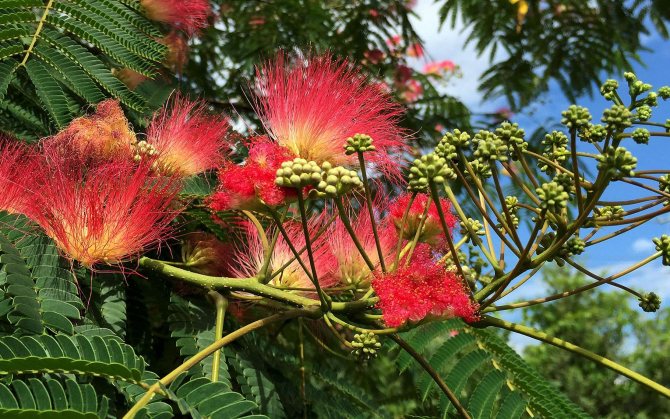

In some countries, albicia is used as a folk remedy for diseases.
Lankaran, or silk acacia - the most catchy variety of the entire genus Albizia due to its spectacular flowering. It is also called mimosa for a similar predisposition to foliage foliage in the dark. It is a thermophilic plant, as it comes from the tropics. Therefore, in our country albicia is grown in the open field only in the south, mainly in the Crimea, Krasnodar Territory, Georgia, Armenia and Ukraine. It belongs to the decorative representatives intended for open spaces. It is decorated not only with private gardens, but also with parks, squares and streets of megalopolises.
Depending on the growth conditions, albition can be a tree or shrub.... The trees grow up to 15 m tall and with a spreading crown 6–7 m in diameter. A lot of space is vitally important for such an acacia, so you will not find it in greenhouses and other enclosed spaces. The second variety includes breeding forms of more compact dimensions, which have retained decorative indicators from the "parent". They are cultivated at home.
When breeding Lankaran acacia indoors, one factor should be taken into account - during flowering, it forms toxic pollen, which can cause allergic reactions in others.
Albizia reaches its peak of decorativeness during flowering, which falls in mid-summer and lasts until autumn. At this time, the entire crown of trees is completely covered with white-pink paniculate inflorescences. When growing Lankaran acacia, a number of its features should be taken into account:
- low frost resistance - temperatures below -13 ° C can destroy the plant;
- increased light-requiring - prefers bright light and cannot stand shading from nearby trees;
- moisture-loving, but firmly tolerates a short drought;
- the root system is well developed, but vulnerable due to its superficial location;
- loves warmth - the optimal summer temperature is from +26 to 28 ° C;
- not particularly picky about the soil, but grows better in sandy loam and fertile;
- does not suffer from salt spray if landed next to the sea;
- smoke and gas resistant;
- calmly tolerates pruning.
In the regions of central Russia and the North, albition is grown exclusively at home or in greenhouses, since this tropical beauty will not tolerate a harsh winter in the open field.
Video: description of Lankaran acacia
Role in landscape design and examples in the photo
These spectacular giants look harmoniously both alone on a personal plot, and in combination with other vegetation in city alleys and parks. Besides its aesthetic function, wood can also be beneficial. Its powerful trunk is ideal for attaching a summer cottage swing. And the luxurious spreading crown will serve as a cover for a gazebo, dining table or relaxation area. The aroma emanating from albicia contributes to the creation of a comfortable and romantic atmosphere. It is unlikely that it will be possible to hide from the midday heat under the shade of silky acacia, since the delicate foliage does not hold the sun flux well.
Light-loving plants can be planted under albicia thanks to the through crown. If you plant Lankaran acacia seedlings along garden paths or city alleys, then at least five years later, a green tunnel will form, since the foliage is closed by a dome.
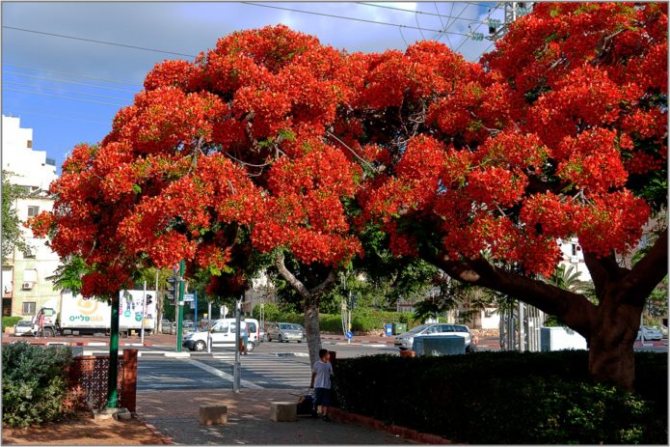

Albicia in bloom


Miracle tree that will not leave anyone indifferent
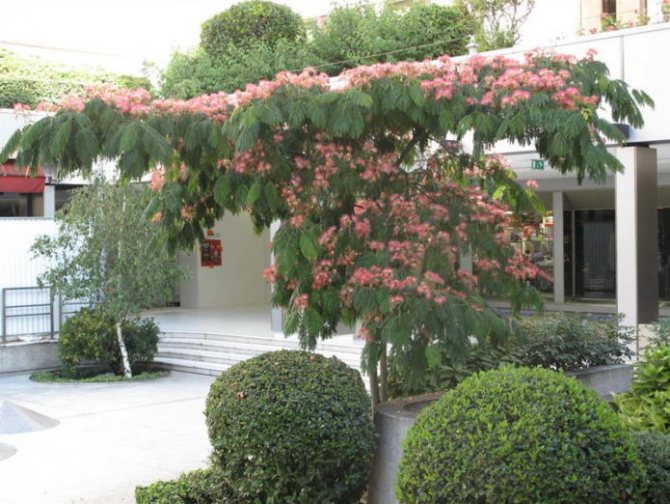

The tree that adorns the front door
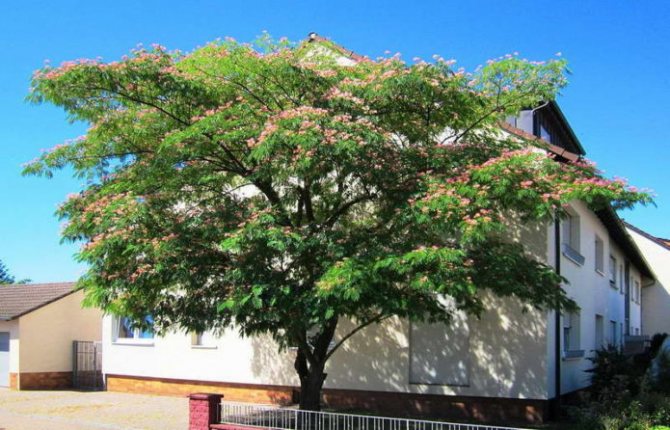

Albizia near the house
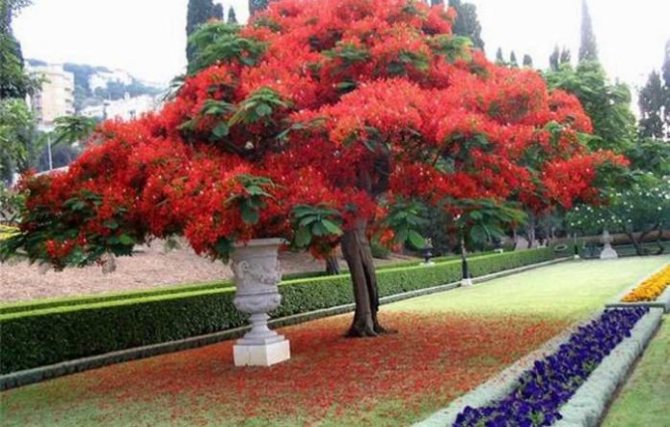

Lankaran acacia along the railway tracks
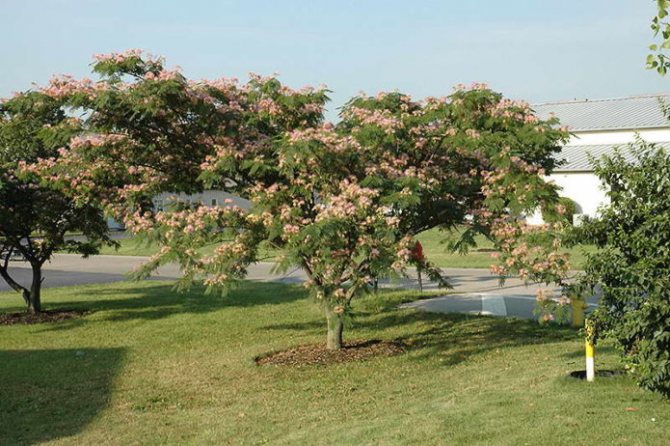

Silk albitsia in the city square
Reproduction, difficulties in growing acacia
In nature, acacia produces multiple root shoots. Cuttings are cut, rooted in the ground at a temperature not higher than + 16 ° C. The process usually takes no more than a month. Monitor the condition of the soil, the ground should not dry out and waterlogged. Side shoots of an adult tree are also suitable as cuttings. They are harvested in early summer, rooted in the same way.
It is quite easy to propagate acacia by seed. The material is pre-soaked in warm water for swelling, after which it is treated with a growth stimulant. They are planted in cups with a nutrient mixture. The containers are placed in a greenhouse or covered with polyethylene.


In the southern regions, acacia is most often kept as a garden plant. In the garden, the culture is rarely sick and is not affected by pests. The condition of indoor acacia is judged by the appearance of the leaf plates. Lack of light will affect the color of the leaf, wilting is a sign of not only overdrying, but also the plant's gulf. Low air temperatures cause dark spots to appear on acacia trees.
Of the pests, spider mite infestations are possible. You can get it from other home flowers, the "visit" of an insect is often associated with dry indoor air.
Many people associate Lankaran acacia with vacations and rest in southern countries. For home maintenance, this is a rather unusual and exotic culture.
Do you want to grow Lankaran acacia in your garden or on your windowsill?
Interesting facts about albition


Silk albitsia contains a lot of useful substances. It was included in the lists of medicinal plants in pharmaceutical directories as an effective remedy for many diseases since the middle of the 19th century. All its properties are actively used in cosmetology, since the parts of the plant contain a large amount of minerals, essential oils and amino acids, as well as a large amount of elements useful for the human body (among them: iron, magnesium, potassium, zinc and others).
Tinctures containing albition act as an antioxidant agent, and have the property of completely neutralizing the actions of molecules that can cause premature aging of skin cells.
Extracts from parts of the Lenkovan albicans are successfully used to provide a diuretic and choleretic effect (the properties are the same as those of extracts from the Opuntia cactus). It is possible to cure bronchitis with them, and by its properties the plant can compete with other medications providing expectorant, anti-inflammatory and heat-lowering action. And as a remedy, these solutions are indispensable for the treatment of young children.
If you take albicia extract with depletion of the body and general loss of strength, it works as a general tonic.
The bark of the tree and preparations based on it can help with gastritis or peptic ulcer disease. And also on the basis of powdered bark, ointments and rubbing are made, which are used for varicose veins, osteochondrosis or radiculitis. This is all due to the tannins that the bark of the "silk bush" is full of; they have a very positive effect on problems caused by inflammation of the internal organs (gastrointestinal tract, genitourinary and respiratory systems). If you apply applications from the bark crushed into powder, you can get rid of abscesses, boils, etc.
Albizia wood is very popular in furniture and handicrafts. It has textured characteristics, hardness, amenable to polishing and is not subject to decay. Also, paint is produced from the bark of the albition trunk, which is used in the dyeing industry.
It is interesting that when planting albition in a personal plot, its growth will help to refine the soil and enrich the substrate with nitrogen.
If you collect teas in which there will be silk albition flowers, then they are good to use to relieve stress, eliminate insomnia and sclerosis, as well as squeezing sensations in the chest. Can this tip help with digestion, robotic heart and stimulate bowel function.
Extracts and extracts of albition are injected into toothpastes, and this helps to strengthen the gums and prevent tooth loss.
However, there are contraindications in which it is necessary to abandon the use of infusions, extracts and solutions based on albition:
- pregnancy;
- all acute conditions;
- lactation period;
- childhood.
"Constantinople acacia" has always been considered a sacred tree in India, it is dedicated to the deity Brahma. In those areas, there are whole albic thickets, which contribute to rescue from the heat and reduce the ambient temperature in areas with an arid climate. Since there are no toxins and tannins in the leaf plates, they are fed to livestock in India and this solves the problem of a lack of animal feed. Under the wide umbrella crowns of albicia, the soil always remains moist and thanks to this, the grass growth becomes of better quality and more juicy, and is used for harvesting.
According to Ayurvedic connoisseurs, albitsia fruits have an astringent taste and a bitter aftertaste, but they have a cooling, light and dry properties and are one of the main plants included in the Ayurvedic system.
Almost all parts are used in the plant: bark, flowers, leaf plates and seeds.
When and how it blooms
The variety of forms of inflorescences, their color and arrangement of foliage, divided albition into several species.
This is about:
- silk (Lankaran, or Iranian) variety (Albizia julibrissin), which is characterized by fern-like leaf plates, consisting of asymmetric sickle-shaped lobes, and dense capitate or spike-shaped flower brushes, in which corollas and many long stamens are almost invisible;
- bunch-flowered (Albizia lophantha), a feature of which is considered to be yellow cylindrical flower ears, the length of which often reaches 5 cm.
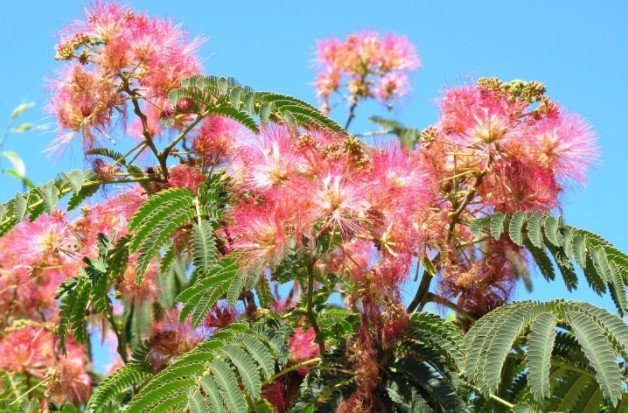

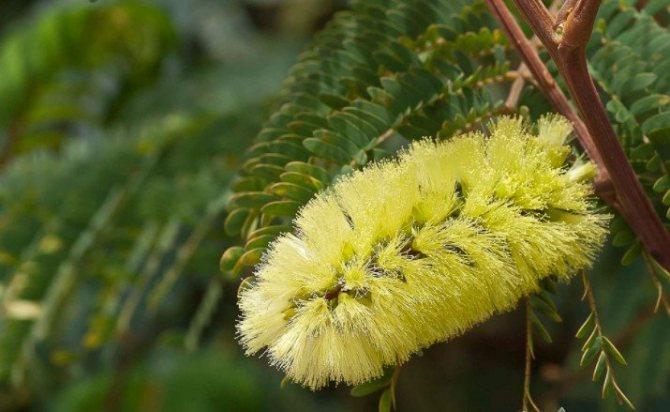

Did you know? Since ancient times, any type of acacia has been considered a symbol of stability and renewal. This is evidenced by the mention of the plant in documents found by historians. And on ancient Egyptian artifacts, archaeologists still find images of sarcophagi with acacia sprouts growing from them. These pictures eloquently indicate that life comes only after death.
Both types of silk tree are distinguished by long flowering... In the first variant, this period begins in the last decade of May and under favorable climatic conditions can last until October. In the warm autumn season in Crimea, cases were recorded when a tree delighted passers-by with fragrant flowers until the frost itself. The second variety is distinguished by earlier blooming of buds. The plant enters this phase from March to June.
Silk and tuft-flowered acacia has very fragrant and melliferous flowers. Moreover, a pleasant smell with pronounced notes of raspberries and violets persists throughout the entire flowering period.
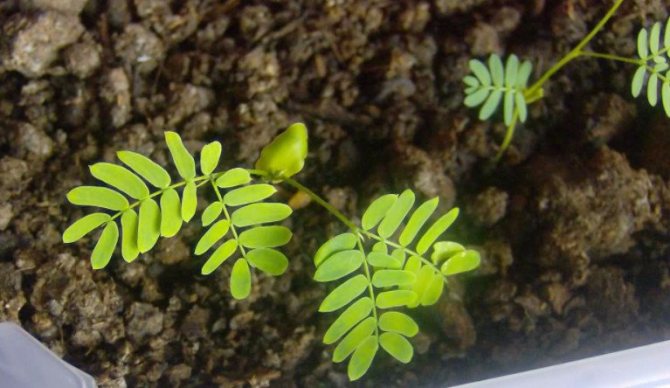

Watering albicia
Watering is carried out as the upper ball of the soil dries out. It is watered abundantly, but the water should not stagnate in the roots, which is why holes are needed in the growing container.
In winter, watering is reduced. The soil at this time should be only slightly moist, but the complete drying of the earthen coma is unacceptable.
During the growing season, once every two weeks, a complex mineral fertilizer is applied for decorative deciduous plants.
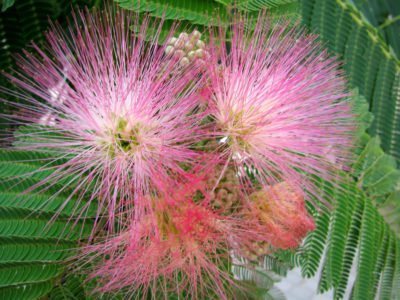

Varieties
The genus Albitsia contains about 30 species. The most common varieties are:
Lankaran Albizia - also has many other names: sleeping bush, silk tree, silk acacia.This albition got its “silk” name due to the fact that earlier the bark of the plant was used for dyeing silk fabrics. The homeland of this species is considered to be the city of Lankaran, Azerbaijan. Nevertheless, in Asia, this type of albition is extremely common and is found everywhere. On the territory of Russia, in the wild, this species can grow on the territory of the Crimea peninsula and in the coastal part of the Caucasus. The most common varieties of Lankaran albicia are Summer Chokolat, Mollis, Tinky Bells, Jjulibrissin. Sickle is the fastest growing tree on the planet. In one day, this type of albition grows by 3 cm. It is cultivated in Indonesian countries. The species has become widespread due to the light soft wood, which is often used as a raw material for souvenir products. Albizia Lebbeck is one of the tallest representatives of the genus. Mature plants can grow to a height of 20 m or more. The homeland of this species of albition is India. Also, the plant is common in the Andaman Islands and Burma. In these regions, Shirisha - the local name of Lebbek, is used as an element of aromatherapy and medicine. Albizia Saman - the tree reaches a height of 25 m, the crown is spreading - up to 40 m. Homeland - the insular part of the Pacific Basin, South and Central America, Southeast Asia. Depending on the variety, the inflorescences are colored beige or reddish. Albizia Lofanta, otherwise - bunched. It is a thermophilic spreading shrub that reaches a height of 5 m. Homeland - Western Australia. The flowering period begins in July. The inflorescences are small, up to 2 cm in diameter, painted in golden yellow, collected in heads and similar to cleaning brushes. Since 1803, it has been cultivated in European countries as an ornamental crop. On the territory of the Russian Federation, the plant grows on the Black Sea coast of the Caucasus and the Crimea peninsula.
How to grow bonsai from Lankaran acacia
Since silk albition is not bad for formative pruning, you can try to grow it in the form of a miniature tree - bonsai.
First, it is worth deciding on the shape of the future tree. In nature, albition most often has a multi-stemmed shape or powerful lateral branches on a short central trunk and an umbrella-shaped crown. But, due to the fact that acacia gives new stem buds well, you can choose any style of bonsai.
It is possible to grow albition Lankaran bonsai both by cuttings and seed methods. When growing, remember:
- a container for growing bonsai should be taken from a ceramic, small, with large drainage holes;
- in no case should shading of the lower branches be allowed, otherwise they will die;
- the roots and crown are best trimmed after flowering;
- periodically you need to carry out corrective pruning of the crown;
- wire winding, to give the branches a shape, should be done no more than once every two years and for no more than 4 months;
- when wrapping with wire, do not tighten it too much, as this can damage the bark of the plant;
- since acacia leaves have a complex shape and give decorative effect, their artificial removal does not give any effect, therefore it is not applied;
- bonsai must be replanted every two years.


The most acceptable height for a miniature silk tree is about one meter.
This is how you can turn a silk Persian tree into a real work of art. This will add a southern flair and will be a great addition to any interior.

